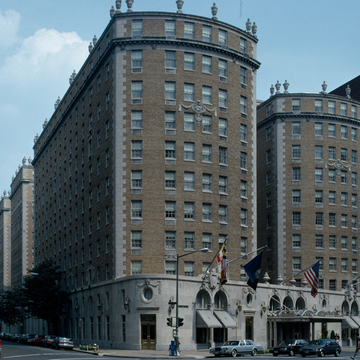Warren and Wetmore, architects of Grand Central Terminal in New York, designed the venerable Mayflower Hotel. Robert Beresford of Washington assisted the firm in executing the design. The Mayflower offered first-class hotel accommodations, dining rooms, and ballrooms in the sections of the building closest to Connecticut Avenue. To the rear, with its own private entrance off a quiet street, was the apartment house tower. Today, nearly all of the apartments have been converted to hotel rooms and the public rooms restored to their original elegance.
The Mayflower Hotel rises ten stories and extends east an entire city block from Connecticut Avenue to 17th Street. The buff brick building is set upon a limestone base. Its main facade on Connecticut Avenue is shaped into a pair of curved towers flanking a deep narrow court above the hotel's main entrance. Stone quoins set off the building's corner. Classical urns and carved cornucopias, wreaths, and swags adorn the facade. On the interior, a grand lobby encrusted with plaster ceilings, marble, and gilding extends the length of the building.

















